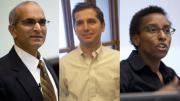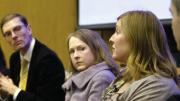Pondering its prospects during Harvard’s 375th anniversary year, the Faculty of Arts and Sciences (FAS) held two late-winter panel discussions about “The Future of the Present”—opportunities for designated professors to examine, respectively, how research and teaching might change in the next quarter-century, and what present strengths and values they hoped would endure as the enterprise evolves.
Moderator Maya Jasanoff, professor of history, began the initial conversation, on February 16, by looking back two decades to her freshman year at Harvard, when iPhones, iPads, Google, Wikipedia, and Twitter didn’t exist and even e-mail was rarely used. Looking ahead to 2036, she encouraged her colleagues to speculate on “how the digital revolution is changing what we do as scholars and teachers, and what we can do in response to it.” Among the highlights of their presentations:
Professor of astronomy David Charbonneau addressed “the exponential increase in data, and the ways we collect data.” The robotic telescopes he uses to search for extrasolar planets already collect 10 to 20 gigabytes of material per night, and new devices will collect orders of magnitude more—requiring data management and analysis skills alongside physics or astronomy training. Researchers in the field are generating 7,000 papers monthly, posing obvious problems in keeping up with the torrent of discovery.
Such discovery, of course, does not come cheap. Professor of biogeochemistry Ann Pearson noted that “minor instrumentation” in her field is “anything that costs less than $2 million”—and naturally, all scientists clamor for the latest, fastest, most powerful devices, to keep pace with peers.
Digitization “is affecting the humanities, but only slowly,” according to Martin Puchner, Wien professor of drama and of English and comparative literature. He described how a Google-assisted search enabled him to locate more than 100 examples of “extremely obscure plays” in which Socrates figured as a main character—part of a project on Plato involving inquiries into drama and philosophy. As general editor of the Norton Anthology of World Literature, he wondered whether, when Harvard is 400, traditional departments focused on national literatures will even exist.
Agassiz professor of zoology Hopi Hoekstra focused on the classroom, today “a sea of laptops” and perhaps tomorrow an empty venue as students take in lectures (if those are still given) from bed. Underscoring what some of her colleagues had said, she noted, “Now, students are analyzing a lot of data, and are spending less time in the lab gathering data.”
Jasanoff took up these themes at the March 7 session, propounding an almost dystopian view of Harvard at its four-hundredth anniversary looking back to 2012: an era when “Widener was full of books. People checked them out” even though they were “chunky, heavy things” and—perhaps even more remarkably—when professors still wrote books and students attended classes between 10 a.m. to 4 p.m., rather than (in 2036) working at internships or on their start-up ventures.
Were her projections tantalizing or frightening? Jasanoff asked. Then she called on her colleagues that day to tease out those attributes of academic life—classroom interactions, scholarly disciplines, liberal-arts verities—that might persist in decades to come, when students would have to adapt continuously, collaborate, and hone their skills in interpreting information across geographic distances, disciplines, and stages of life.
Claudine Gay, professor of government and African and African American studies, asked, “What function should the Harvard campus serve when virtual classrooms reach across the world?” She said her “nostalgia for the present” might make her seem a Luddite, but she felt strongly that place matters for education, just as citizens’ social and economic contexts shape their voting behavior and political beliefs. Much as “citizens are not unmoored social isolates,” it is virtually “axiomatic” that a physical campus matters to students and scholars. “Discovery,” she said, “is not possible without dialogue”—and a campus is “the only place where the caravans meet.”
Professor of psychology Matthew Nock, echoing Charbonneau, said that 1.5 million new journal articles a year meant researchers were ever more dependent on the disciplines and processes of peer review to “organize and navigate that information” and help separate science from “nonscience.” Online tools might speed such reviews and subject the underlying data to greater transparency, but the process of peer vetting must remain intact.
In an interdisciplinary era, said associate professor of electrical engineering Robert Wood—who collaborates on an enormous project to design microrobots, with eleven principal investigators—classical disciplinary training remains essential. Engineering is, in that sense, “an inherently historical discipline.”
Support for that view came from an utterly different direction, from professor of religion and Indian philosophy Parimal Patil, who studies those subjects as they arose in classical Sanskrit texts. Making the case for the liberal arts, Patil cited two core intellectual values: “the value of slow academics” (of deep analysis—in text, laboratory experiments, or the formulation and testing of hypotheses—driven by curiosity, rather than for any instrumental purposes); and “the importance of talking to all the wrong people” (from other disciplines, who can challenge one’s assumptions through “genuine, heated, but intellectually productive conversations”). To that end, he advocated that professors “take each other’s courses.”
It was a vivid way of illustrating the value of a physical campus, of chance encounters and personal interaction—even as an era of digitally assisted, global research and teaching unfolds. As Jasanoff summed up, the panels themselves had proven several speakers’ point about “the value-added of getting people into the same room, across disciplines, in unusual combinations.”










